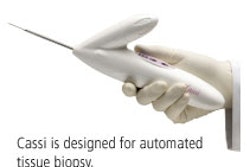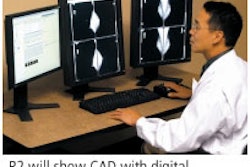This article originally appeared in the "Mammography Regulation and Reimbursement Report," written by Dan Oakey, mammography coordinator for the state of Florida and a certified MQSA inspector.
The phone rings, and it's the Mammography Quality Standards Act (MQSA) inspector calling. He or she is coming to inspect your facility five days from now. Are you ready?
By taking a few simple steps (such as organizing your records and creating a personnel checklist), you can greatly increase your chances of a successful inspection.
When an inspection date is set, your facility will usually receive a faxed confirmation, which includes not only the time and date of the inspection, but details about what the inspector will look for when he or she arrives, such as the following:
- Equipment performance tests
- Mammography equipment processing
- Quality assurance records
- Quality control (QC) records
Take note of these critical points and use them to prepare for the review.
The inspector will also look at your medical outcomes audit to see whether you follow up correctly on suspicious or highly suspicious cases. He or she will want to see five randomly sampled medical records to ensure that you use the proper nomenclature and that the records contain mammography films and records. He or she will also look to determine the involvement of your lead interpreting physician.
The inspection will probably begin with a meeting with your team members, an administrator, the lead interpreting physician and physicist (if available), and your QC technologist.
From there, the inspector will probably start the inspection by conducting equipment tests. Note that you don't have to cancel all of your patient appointments on the day of the inspection. The inspector will likely only spend 15 to 20 minutes performing the necessary tests on each piece of mammography equipment and can work between appointments. Your inspection won't involve much downtime, even if you are a single-machine facility.
After the machines are tested, the remainder of the inspection will focus on your facility's documentation of your mammography program during the past year.
A facility can earn extra points with an inspector and greatly reduce its frustration and stress if all of the necessary paperwork is organized and available for the inspector to review. Putting the information into the following three easy-to-access binders can help keep your inspection on track:
The first binder should contain all the policies and procedures that the inspector will review, such as assignment of responsibilities, consumer complaint policy, infection control policy, and the medical audit. It should also include all signed reviews, physics surveys, and documentation regarding when equipment has been reviewed or repaired.
A second binder should contain all the required QC tests by the QC mammographer. This should include all equipment tests and documentation of corrective actions from those tests.
A third binder should contain personnel qualification records. Some facilities take personnel records directly from a medical credentialing committee and include them in a folder for each member. This leaves the inspectors to wade through irrelevant documentation, such as narcotics licenses, preceptor statements, training and continuing education, or experience not related to mammography.
By filtering out the unnecessary information, you can streamline the inspection process. Taking this step will also help you ensure that you have the necessary documents to demonstrate the mammography qualifications of your staff.
With this in mind, it's also a good idea to create a checklist for your personnel folder to indicate that each individual has the necessary initial training and continuing education and experience documentation. It can be difficult to track personnel records because they are constantly changing -- like trying to hit a moving target. The checklist will help you ensure that you have all the required documents before the inspector arrives.
Don't go too far
Although it's important to take the time to organize your records, you shouldn't try to improve them. Inspectors know that QC records are working documents prone to corrections, coffee stains, and cross-outs.
One of the biggest mistakes I see facilities make is viewing QC records as formal documentation. Staff will sometimes rewrite processor records to try to make them neat and presentable and, in the process, omit days on which the processor was getting close to being out of limits in an attempt to make the records look better.
This is a big mistake. The purpose of processor records is to tip off staff that a problem may be brewing so they can avoid larger problems. In addition, removing information and rewriting documents amounts to falsifying records, which can create more problems for your facility than your efforts will solve.
In addition, many facilities make the mistake of not including enough information on their records. For example, the explanations for failure of weekly phantom-image testing might be inadequate. The form might note that corrective action was taken but not outline what that action was or whether it was approved by the medical physicist. Make sure your records include these details.
Facilities should also let the inspector know whether any unusual circumstances might have negatively affected the facility's performance. For example, unusual weather (such as flooding from hurricanes), fire, or vandalism that results in a temporary closure of your facility should not be cause for a penalty against the facility. Likewise, a problem employee who made a series of mistakes that have since been corrected without a negative effect on mammography quality should not count against the facility. Make sure the inspector is aware of any of these unusual events. He or she may take this into consideration when conducting the review.
It's important to understand that most inspectors try to enter facilities with their eyes and ears open and their mouths shut. They're not looking for liars or cheaters, but it becomes readily apparent to an experienced inspector when things are not as they should be.
It doesn't take long to spot manufactured, falsified, or improved records. Letting the inspector know about problems ahead of time will benefit you in the end.
Facilities should also understand that inspectors are not there to put them out of business or shut them down. Although their role is not that of a consultant, they are there to help facilities by providing them with the information they need to maintain certification and improve mammography quality.
By Dan Oakey
AuntMinnie.com contributing writer
March 3, 2006
The "Mammography Regulation and Reimbursement Report," is a 12-page monthly newsletter designed specifically for mammographic technologists and supervisors that is published by HC Pro. The periodical offers ideas for better practice management from peers, billing tips, MQSA regulatory updates and guidance, and business ideas related to breast imaging. For a free trial subscription, please click here.
Related Reading
RT admits falsifying mammography QC reports, January 13, 2006
ACR's breast imaging accreditation expands on MQSA, October 11, 2005
MQSA Made Easy, Understanding and Implementing the Facility-Based Final Regulations, August 8, 2005
RT bears burden of QA failure at PA mammo clinic, June 9, 2005
PA mammo clinic fails QA, must pay for re-screens, January 7, 2005
Copyright © 2006 HC Pro



















